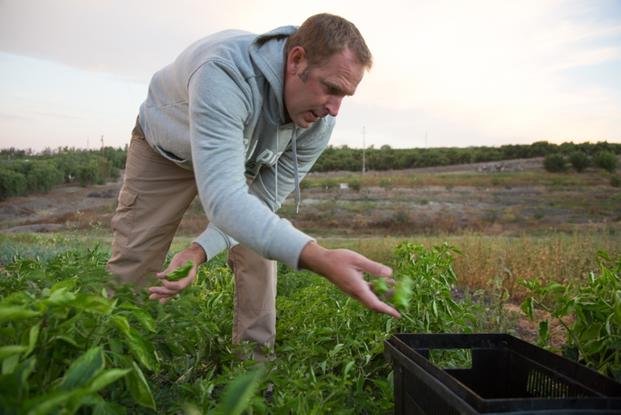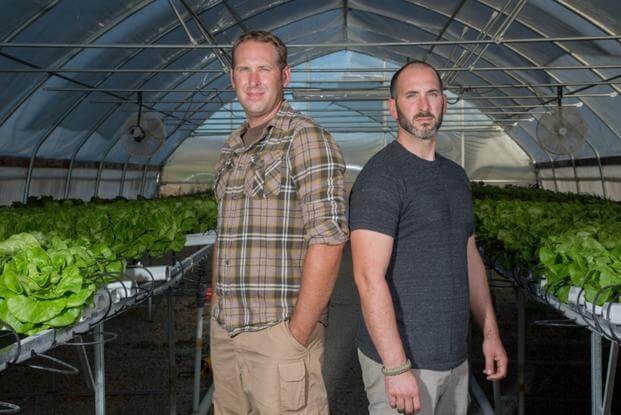Growing up on a 15-acre family farm in central California, Morgan Boyd never dreamed of a career in agriculture. He recalled harvesting corn by hand in the sweltering heat in the Huasna Valley and hawking produce at farmer's markets around San Luis Obispo County.
"I didn't see the farm as something I ever wanted to pursue at all," he said.
But after serving a dozen years in the Army, during which he deployed to Iraq and Afghanistan, he was medically retired and struggling with post-traumatic stress disorder and traumatic brain injury. He found peace back on the farm.
"My transition out was really rough -- I didn't know what I was going to do with my life," he said in a telephone interview with Military.com. "I was coming home and helping my family on the farm, and I was finding a lot of peace and solitude and, to be quite honest, some healing out there."
Now, Boyd, a remarried father of two, wants to inspire other veterans interested in trading their combat fatigues for overalls. He launched the Farmer Experiential Education and Development, or FEED, program at California Polytechnic State University in San Luis Obispo to give beginner farmers a crash course in farming.
Morgan Boyd, an Army veteran of the wars in Iraq and Afghanistan, has launched the Farmer Experiential Education and Development, or FEED, program at California Polytechnic State University in San Luis Obispo to give beginner farmers a crash course in farming. (Video courtesy Cal Poly)
Combat Fields to Cornfields
Boyd enlisted in the Army shortly before the Sept. 11, 2001, terrorist attacks, along with his younger brother, Eric. The two attended Basic Training together, served as cavalry scouts in the same unit -- the 3rd Armored Cavalry Regiment -- and even deployed to Iraq together.
Eric was shot in Iraq and medically retired from the service. Morgan continued to serve, became an officer and led a reconnaissance, surveillance and target acquisition, or RSTA (pronounced "rista"), platoon in a particularly volatile part of Afghanistan as part of the 5th Stryker Brigade Combat Team.
"Our brigade still to this day has the most KIAs out of any brigade that went to Afghanistan," he said, referring to troops killed in action. "It was a rough deployment. It was a tough go. That kind of affected me more than Iraq did."
After returning from war, Boyd sought medical treatment for injuries to his shoulder and back. He was surprised to learn that despite being a captain with 12 years of experience and combat deployments under his belt, he would be a casualty of the Army's push to downsize the force.
"I was a senior captain -- I thought I was going to spend 20 years in the service," he said. "They decided to tell me it was time to go, which was a tough pill to swallow at the time. Looking back now, I'm really grateful that it happened."
Back to School
In addition to taking over operations of his family's Pepper Creek Family Farms in Arroyo Grande, Boyd started taking classes at California Polytechnic State University, known as Cal Poly, where he received a master's degree in with a focus in veteran employment and sustainment agricultural policy.
He came up with the idea for the FEED program at Cal Poly after learning of the Farmer's Veterans Coalition, a 9,000-member nonprofit based in Davis, California, which works to connect veterans with jobs in agriculture. The coalition offers a Farmer Veteran Fellowship Fund to provide financial aid to vets who want to work in agriculture and a Homegrown by Heroes Label to distinguish veteran produce in the marketplace.
Michael O'Gorman, executive director of the coalition, praised the efforts of Boyd and his brother Eric, who teaches a soil management class at Cal Poly's Pomona campus. Like the Boyds, many veteran farmers boast traits well-suited for farming or other careers in agriculture, he said.
"Work ethic is huge" for these jobs, he said. "Determination -- not giving up easily, standing up after you've been knocked down. A symptom of PTSD -- hyper-vigilance -- that's the best thing you could take to a farm. That's a trait you look for in somebody -- somebody with eyes in the back of their heads and sleeping with one eye open."
O'Gorman also said that while the solitude of the farm attracts many veterans to the field, it can also be dangerous -- and it's important for people entering these careers to maintain personal relationships with colleagues and professionals.
"Farmers in general have high incidence of suicide and depression because of isolation," he said. "A lot of what we do is try to make vets in our program talk to other people."
Indeed, PBS recently aired a movie, "Farmer/Veteran," about Alex Sutton, a veteran who struggled to keep up with the work on a 43-acre family farm he took over from his grandfather, who purchased the property after his own service in Korea.
Revitalizing Rural Communities
While the numbers are sometimes debated, Boyd said roughly 44 percent of service members come from rural populations, but only 24 percent of them stay in rural areas after leaving the service in part because of the lack of economic opportunities.
"A lot of our veterans are not staying in rural communities -- they're leaving when they get out," he said. "But what we're starting to see is a lot of veterans are trying to find a way to get back."
There are 20.1 million veterans in the United States, according to the Census Bureau. Of those, 4.8 million, or about 24 percent, live in rural areas, mostly in the South and Midwest, according to a January report from the bureau. By comparison, some 15 million vets live in urban areas.
Of the vets who live in rural areas, only about 70,000, or slightly more than 1 percent, work in agriculture -- or related jobs such as forestry, fishing, hunting and mining, according to the report.
But there is a push from government officials to develop strategies to reinvigorate rural communities, which have seen a decline in economic activity in recent decades as more of the population flocks to cities, Boyd said.
"I think bringing back veteran farmers is a great natural progression," he said.
Not Your Typical Ag Course
The FEED program is an intensive, 12-week foundational course designed to introduce vets and other interested applicants to farming, Boyd said. It's one of just a handful of such programs in the state to be certified by the Veterans Affairs Department and eligible for GI Bill benefits coverage, he said.
The 15-credit course is estimated to cost $6,000, excluding room and board, and is designed to accommodate up to 24 students per quarter, Boyd said. The university is currently accepting applications for a course scheduled to run Sept. 5 through Dec. 15. Information on how to apply can be found at its website.
The goal is to provide students with a cross-section of courses that combine classroom work and field experience over a relatively short period so they can seek employment on a farm, start their own business or find other jobs in the agricultural industry, according to Dr. Brian Tietje, vice provost for international, graduate and extended education at Cal Poly.
"Most ag education is very focused on large-scale production agriculture, and the assumption is then that there are high degrees of specialization so, for example, if you look at an ag school and their curriculum, they're not claiming to teach you to be a farmer -- you might choose a major in crop science," he said. "I do believe that something like this could serve any number of potential markets."
As for Boyd, he's working to get word out about his program and encouraging veterans to apply, especially those who recently separated and may be struggling to adjust to life without the structure and camaraderie they're used to.
"That six-month window of post-separation is, quite frankly, a dangerous time in many veterans' lives," he said. "They're kind of left to their own devices and that can be dangerous.
"Not every veteran is prepared to enter into a four-year university -- they're just not, to be very honest," Boyd added. "A lot of veterans have these educational benefits that they should be able to apply to training programs that meet their own personal needs, and that to me is where this program fits."
-- Brendan McGarry can be reached at brendan.mcgarry@military.com. Follow him on Twitter at @Brendan_McGarry.
Related content:



























